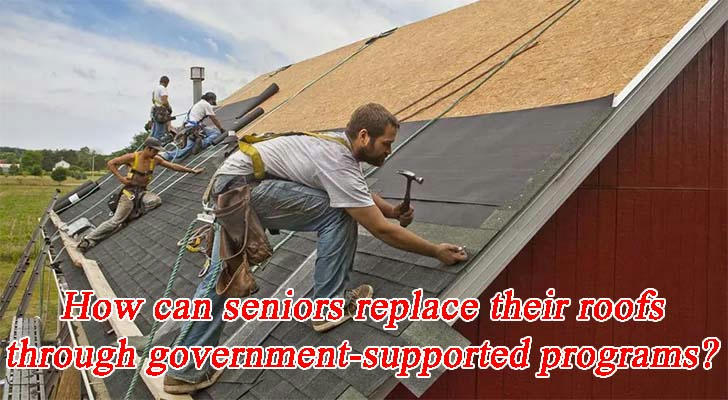How can seniors replace their roofs through government-supported programs?
Replacing a damaged roof can be a major financial burden for seniors, especially those on a fixed income. With costs ranging from $5,700 to $12,500, many older adults struggle to afford roof repairs. Fortunately, government-supported programs can help reduce these costs, providing vital assistance to ensure seniors can maintain a safe and secure home.

1. Understanding available government-supported programs
(1) USDA Section 504 Home Repair Program
Rural seniors (62+) with low income may qualify for up to $7,500 to fix health or safety hazards, including roof replacement. Additionally, a low-interest loan of up to $20,000 may be available, which can help cover a significant portion of the repair cost.
(2) HUD Programs (Title 1 and 203(k) loans)
The HUD Title 1 Property Improvement Loan and 203(k) Rehabilitation Mortgage Insurance allow seniors to include roof replacement costs in a low-interest loan for home repairs. This program is ideal for urban seniors and provides flexible repayment options.
(3) Community Development Block Grants (CDBG)
Municipalities can use CDBG funds to assist seniors with home repairs, including roof replacement, under $10,000. In some cases, a combination of loans and grants can be used to cover larger projects.
(4) State-Specific Programs
Some states offer specialized programs, like the Home and Community Care Block Grant in North Carolina, which provides up to $7,000 per year for seniors needing home repairs, including roofs.
(5) Low-Income Energy Assistance Program (LIHEAP)
While primarily for heating and cooling bill assistance, LIHEAP in some states offers funding that can be used to replace roofs to improve energy efficiency. This not only fixes leaks but also reduces long-term heating and cooling costs.
2. Comparing Costs vs. Aid Potential
| Scenario | Roof Cost Estimate | Possible Support |
|---|---|---|
| Small home (1,500 sq ft) | $6,750–$9,000 | Section 504 support $7,500 → can cover a significant portion of costs |
| Mid-size home (~2,000 sq ft) | $9,000–$12,500 | Loans/support up to $27,500 → can cover most of the costs |
| Urban area with HUD support | $9,000 average | Title 1 or 203(k) financing → flexible repayment options |
| County program via CDBG | Varies by repair | <$10,000 may be covered → direct support for repairs |
For many seniors, a combination of these programs can significantly reduce the cost of roof replacement, depending on their situation.
3. How to Apply for Assistance
Step 1: Verify Eligibility
Check if you meet the age, income, and residency requirements. Your roof must also be deemed unsafe or in need of replacement due to damage.
Step 2: Gather Required Documentation
Prepare documents such as proof of identity, proof of income, housing documentation, and roof condition evidence (photos or assessment report).
Step 3: Submit Your Application
Submit your application either online or to a local housing agency. Approval can take several weeks or even months, so be prepared for a waiting period.
Step 4: Work with a Contractor
Once approved, either a government-appointed contractor or one from an approved list will replace your roof. Ensure they adhere to program guidelines to ensure proper fund allocation.
4. Who Can Apply for Assistance?
- Age: Applicants are typically 62 years or older.
- Residency: Seniors in rural areas may qualify for USDA programs, while others in urban areas can access HUD programs.
- Income: Programs require that seniors meet specific low-income thresholds.
- Home Condition: The roof must be unsafe or in need of replacement due to health or safety issues.
5. Age-Based Program Assistance Breakdown
| Age Group | Eligible Programs | Benefits Available |
|---|---|---|
| 62-69 | USDA, HUD, LIHEAP, CDBG | Up to $7,500 in grants, low-interest loans up to $20,000, and potential roof repair assistance through USDA and HUD |
| 70-74 | USDA, HUD, CDBG, State Programs | Additional senior-focused programs and higher loan limits in some states, with up to $27,500 available for repairs |
| 75-79 | USDA, HUD, LIHEAP | Extended access to roof repair grants, and additional support for energy-efficient repairs through state programs |
| 80+ | USDA, HUD, LIHEAP | Priority consideration for health and safety repairs, with the possibility of covering a significant portion of roof replacement costs through available grants and loans |
6. Additional Resources to Lower Roof Replacement Costs
Beyond government programs, seniors can explore other financial assistance options:
- Non-Profit Organizations: Organizations like Habitat for Humanity may assist with home repairs for seniors in need.
- Religious and Charitable Groups: Some local churches and community organizations offer financial aid for roof replacements.
- State and Local Programs: Many states and local governments have additional resources, including grants and loans, for seniors needing home repairs. Contact local housing agencies for details.
7. Conclusion
Replacing a damaged roof is crucial to maintaining a safe home for seniors. Government programs, such as those offered by USDA, HUD, and LIHEAP, provide significant financial relief through grants, loans, and other resources, making roof replacements more affordable. By taking advantage of these programs, seniors can ensure their homes remain secure without financial pressure of expensive repair bills.
